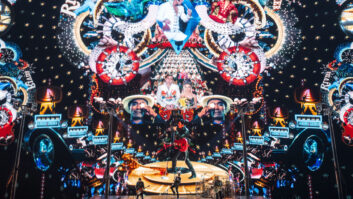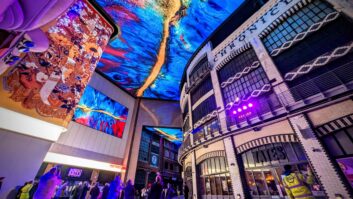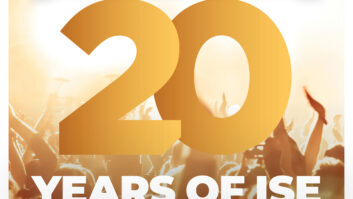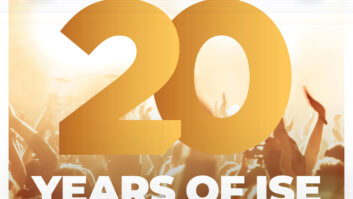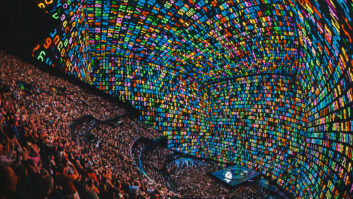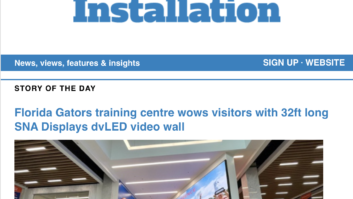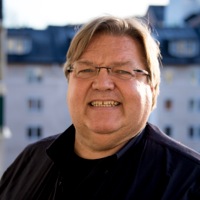
A well-known industry figure in the audio industry, the Finnish active speaker manufacturer’s marketing and PR director spoke to Paddy Baker about Genelec’s past, present and future, and the rise of ISE.
How did Genelec come to specialise in active loudspeakers?
It goes back to the mid-1970s when the Finnish broadcasting company, YLE, was building new premises in Helsinki. Ilpo [Martikainen, company founder, now chairman] was working as an engineer and had made a name for himself designing hi-fi speakers. YLE’s acoustician asked him whether he could make a monitor loudspeaker; Ilpo, being an engineer, said: “Yes I can – what is it?” The Nordic broadcasters’ specification for a monitor loudspeaker said that it should be able to be calibrated to produce a flat frequency response at the listening position. So it was easy to decide that it needed be an active monitor, as then you have full control of the system – with room response controls built in and so on. With a passive system, with external amplifiers and external equalisers, you wouldn’t have any control of the system. So that is the background, and you can say it’s the philosophy that the company has followed ever since.
Is the concept of active loudspeakers well defined, or does the term mean different things to different people?
Today it’s quite well defined: inside an active loudspeaker, the signal goes to a crossover prior to amplification, and there is one amplifier per drive unit. In the beginning – when I started to sell Genelec in 1985 – you could talk about the product and the next question would be “What amplifier should I use?” You don’t get that any longer.
When Genelec started to become successful in the world market in the 1990s, some competitors came up with solutions that just piggy-backed an amplifier on the back of a passive loudspeaker. Nowadays they do it properly.
When did Genelec enter the installation market, as opposed to the broadcast or studio markets?
Actually in the 1980s Genelec was in the contracting business in Finland – it was a way of using the company’s own products. At the time there were a lot of new theatres being built, and Genelec did complete installations. Even abroad – the big circus building in Moscow was done by Genelec. But around 1988 the company decided to focus on being a manufacturer and we ceased the contracting business.
But then, when we introduced the 1029, which was the first product we made from die-cast aluminium, and which could be mounted, we noticed that the product was finding its way into various types of installations – and that has continued ever since. Now with the 4000 series we have chosen to make dedicated products for the installation market.
You’ve been with Genelec 20 years – what was your previous job and why did you make the move?
I have a previous career as a sound engineer in theatre – doing plays and musicals – and I was also involved in a number of new projects where we were building new theatres or installations in older ones. That led me to a lot of contact with various distributors, and one day I got an offer to work for one of them. My first response was “No, are you crazy? I’m a theatre sound engineer” – but a year went by and I thought maybe I should try something new. So I called up one of the people who had made the offer, and it was still standing – this was in 1985.
I worked in distribution in Sweden for seven years before I joined Genelec in 1992. I was selling Genelec during that time, so I have a long relationship with the company. I was also selling a lot of other products, form the UK and the US, so which gave me a good network of people abroad.
Originally I’m an electrical engineer, and my first steps professionally were in the theatre in lighting, but it soon turned into sound.
So there are no plans for Genelec to do what Soundcraft have done, and dip a toe into the world of lighting?
[Laughs] Putting a light into a speaker? No, I don’t think so – but I think what they’ve done is a very clever idea.
What was Genelec like when you joined, compared with today?
We were obviously a much smaller company – around 20 employees – and our factory was really small, even though it was quite new – it was built in 1985. We’ve expanded it three times since then, and we have close to 140 employees.
And the culture changes as the company grows. It’s a totally different company now. When I joned we were basically three people in sales, including Ilpo who was the managing director. Now we are 14 people in the marketing department, and about as many in the sales department – so it’s a totally different brief, and totally different requirements for how to run the company.
How would you say the market has changed over that time?
For us, in monitoring, it definitely has matured. For example, nowadays, if somebody introduces a new monitor to the market it will be an active monitor, and it will have about the same features as our products have. Not everybody includes waveguides, but when it comes to the amplification it will have room response controls and so on.
In the 1980s and the beginning of the 1990s you would still see big passive, wall-mounted speakers being used – that’s very rare today. Maybe there’s a small… I mean with Ocean way speakers and Augspurger speakers, there’s a retro era coming back perhaps, I don’t know. On the other hand, the big recording studio market has really slowed down: if someone invests it would be in China and it’s government money in a broadcasting facility, or it’s in India in a film company with a big control room; or otherwise we send these speakers into residential installations in the US.
What are the major technological changes that have happened during your time at Genelec – maybe outside your immediate sphere of influence – that have made a difference to the market overall?
The only things that haven’t really changed are the two sides of the recording process – the microphone and the loudspeaker. Those function in the same way that they always have, but everything in between has changed dramatically. I mean, when I worked in audio we used tape recorders; I saw one tape recorder at the recent AES show. Studer and Otari used to have big, big stands with tape recorders – you don’t see that these days. Console technology obviously has changed – it’s pleasing to see, for example, SSL, Lawo and Stagetec developing these large consoles.
The next big change will be audio over IP, and that also will affect the console companies – maybe what they will supply will be basically a remote control, and the user interface will be in accordance with what the user is used to. The younger generation is much more prone to use computers for control, rather than expecting to have a big board in front of them – while some of the older generation cannot think of anything but having a big board in front of them. It will be very interesting to see what the future will bring in that respect.
For us, we have been doing quite a bit of work on audio over IP and are well prepared for the day when there will be a market for it. So that’s another big change that we’re moving towards.
What do you see as the key hurdles to overcome before audio over IP becomes a market reality in your sector?
There have been issues with the switchers, which I think are close to being solved. The customers that I see as being most interested in audio over IP are broadcasters. When we showed our prototype systems three years ago we of lots of interest from broadcasters – they see a lot of cost savings in their infrastructure. Also the ability to go wireless is attractive to them.
Wireless must have its own challenges, such as bandwidth and constant connection and so on.
Yes, with the problems you experience as a normal computer user, [wireless audio over IP] feels a bit scary – how can you rely on IP systems at all? But these problems have to be addressed, and you have to have seamless redundancy I guess, before people are willing to invest in it. But I’ve talked to a lot of people at AES and spokespeople for the various systems seem very confident that this will work. For us, as a loudspeaker manufacturer obviously we cannot lead that kind of business. When it turns up we will have to see – there won’t be one dominating system, there will be AVB, Ravenna, Dante and maybe some more – and as a loudspeaker manufacturer we will have to try to talk to all of them.
You’re on the ISE Board of Directors. Why do you think that show has grown almost constantly over ten years?
Very good question – I wish I could answer it! It must have hit something that was missing from very early on. We were there from the beginning as one of the founding members of ISE. We saw in Geneva [the first ISE, in 2003], even though there were just a few exhibitors in the corner of a huge hall, there was a very positive ambience over the show – and that has continued over the years. The word spread, more and more people want to come and take part – and some of the big manufacturers have used the show very effectively to organise dealer meetings and so on.
The first adopters were the pure AV companies, like projector manufacturers, and companies like Crestron and Extron – although the show is not big enough for Extron now. The audio companies were slower to get on board, but now I can’t really see that anyone is missing.
Do you think ISE could ever get too big?
I think it could. It’s more or less the size of IBC as we speak. If it grew much more, it would start to make Amsterdam not big enough, because there aren’t enough hotel rooms. The way hotel room costs go up for IBC is absurd – it’s exploitation, it’s greed. And that closes out a lot of people. Who pays €450 for a hotel room? It’s only if you work for a big corporation that that will happen. I guess ISE will soon face the same problems unless more hotel rooms are built. At IBC, people look at getting hotel rooms as far away as Germany, or in den Haag, or other cities, to get to the show.
Is there also the danger of the show getting too big from the visitors’ point of view?
Yes and no. The halls at the RAI are a reasonable size – it’s not like NAB where the halls are so big that when you stand at one end you can’t see the other; that makes things very difficult. At the RAI, you can do this round trip and you can see all the halls. And of course not everyone who comes is interested in everything.
Of course, after all these years I’m familiar with the RAI and know where all the halls are, but for a newcomer it can be quite difficult to find to find your way around. Signposting is something that the show organisers have to work on quite strictly and consciously.
Genelec is, I think, the first manufacturer in the professional AV world to announce that it intends to comply with the forthcoming ErP directive, which is concerned with reducing the standby power consumption of devices.
We have decided we will comply with the ErP 2013. Whether or not others do it as well, we see it as something very good for the future: we save energy for the users of our products, we save energy for our children and future generations. We also see substantial future gains. If you look for example at what’s happening in the US currently, where InfoComm and others are looking at the EnergyStar certification programme for products; one day in AV installs there will be EnergyStar-related programmes that look at the total power consumption for the complete install. Then it will be very beneficial then to comply with ErP. A normal amplifier in idling in our product consumes 15-20 W – if we can get that down to 0.5W, and if you look at big installations where power tends to be on 24/7, you can save a lot of energy. The aim from the EU is to save 35 terawatts in 2020; and one nuclear reactor produces about one terawatt.
With some European directives or standards – EN54 comes to mind – there seems to be a lack of clarity as to who polices them; also, they can be interpreted differently in national laws, with different timescales. Do you have sight of how uptake is going for the ErP directive across Europe?
We have no idea to be honest. We heard at AES that one audio manufacturer’s lawyers have advised them not to comply because they don’t feel it’s necessary. And that’s their choice – our choice is to comply. We think we do it for a good cause, and that’s basically good enough for us.
Where we come from – we live in nature, our factory is on the forest slope, ending in a lake, and we want the lake water to be clean so we can swim in it, and eat the fish from it and so on. So we feel it’s necessary to fight for a sustainable society.
Do you have any unfulfilled ambitions, either professionally or personally?
Quite honestly, no, I don’t think so. Obviously I’ve been with Genelec for 20 years and I’ve been very happy. I’ve had challenges in my work and I’ve been very happy with that. It’s a fun thing when you can be in a company that’s been successful through the years, and develop things with other people.
Working in Genelec is a very collective thing. Obviously Ilpo is the figurehead and the one who leads, but all of us in the company contribute and do it in a very open and informal atmosphere, which is a very nice place to be. I’m very, very happy where I am and intend to continue for as long as I am allowed to.
